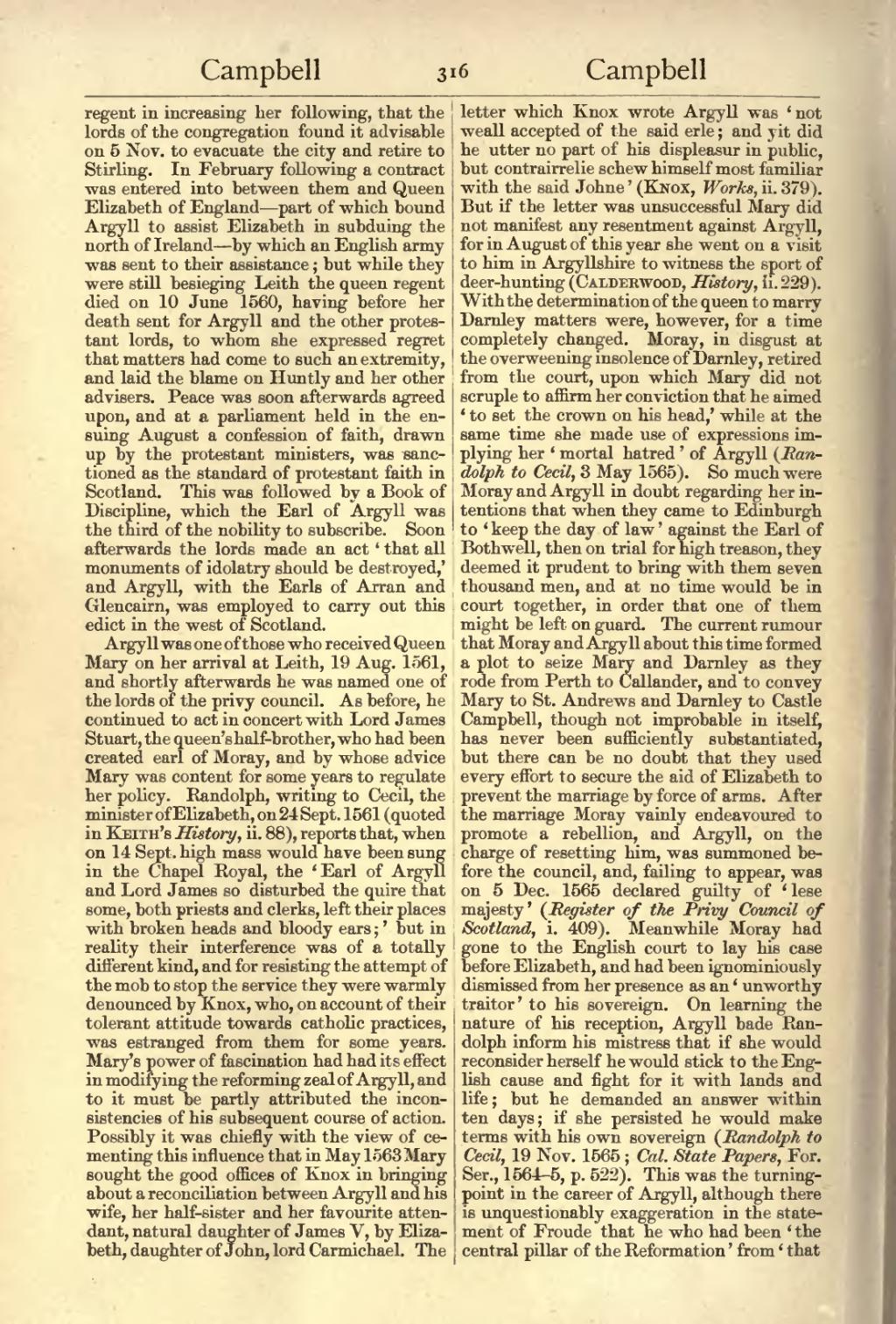regent in increasing her following, that the lords of the congregation found it advisable on 5 Nov. to evacuate the city and retire to Stirling. In February following a contract was entered into between them and Queen Elizabeth of England—part of which bound Argyll to assist Elizabeth in subduing the north of Ireland—by which an English army was sent to their assistance; but while they were still besieging Leith the queen regent died on 10 June 1560, having before her death sent for Argyll and the other protestant lords, to whom she expressed regret that matters had come to such an extremity, and laid the blame on Huntly and her other advisers. Peace was soon afterwards agreed upon, and at a parliament held in the ensuing August a confession of faith, drawn up by the protestant ministers, was sanctioned as the standard of protestant faith in Scotland. This was followed by a Book of Discipline, which the Earl of Argyll was the third of the nobility to subscribe. Soon afterwards the lords made an act ‘that all monuments of idolatry should be destroyed,’ and Argyll, with the Earls of Arran and Glencairn, was employed to carry out this edict in the west of Scotland.
Argyll was one of those who received Queen Mary on her arrival at Leith, 19 Aug. 1561, and shortly afterwards he was name one of the lords of the privy council. As before, he continued to act in concert, with Lord James Stuart, the half-brother,who had been created earl of Moray, and by whose advice Mary was content for some years to regulate her policy. Randolph, writing to Cecil, the minister of Elizabeth, on 24 Sept. 1561 (quoted in Keith History, ii. 88), reports that, when on 14 Sept. high mass would have been sung in the Chapel Royal, the ‘Earl of Argyl and Lord James so disturbed the quire that some, both priests and clerks, left their laces with broken heads and bloody ears; ’ but in reality their interference was of a totally ditferent kind, and for resisting the attempt of the mob to sto the service they were warmly denounced byginox, who, on account of their tolerant attitude towards catholic practices, was estranged from them for some years. Mary’s power of fascination had had its effect in modifying the reforming zeal of Argyll, and to it must be partly attributed the inconsistencies of his subsequent course of action. Possibly it was chiefly with the view of cementing this influence that in May 1563 Mary sought the good oflices of Knox in brin ring about a reconciliation between Argyll and his wife, her half-sister and her favourite attendant, natural daughter of James V, by Elizabeth, daughter of John, lord Carmichael. The letter which Knox wrote Argyll was ‘not weall accepted of the said erle; and yit did he utter no part of his displeasur in public, but contrairrelie schew himself most familiar with the said Johne ’ (Knox, Works, ii. 379). But if the letter was unsuccessful Mary did not manifest any resentment against Argyll, for in August of this year she went on a visit to him in Argyllshire to witness the sport of deer-hunting (Calderwood, History, ii. 229). With the determination of the queen to marry Darnley matters were, however, for a time completely changed. Moray, in disgust at the overweening insolence of Darnley, retired from the court, upon which Mary did not scruple to affirm her conviction that he aimed ‘to set the crown on his head,’ while at the same time she made use of expressions implying her ‘mortal hatred’ of Argyll (Randolph to Cecil, 3 May 1565). So much were Moray and Argyll in doubt regardin her intentions that when they came to Edinburgh to ‘keep the day of law’ against the Earl of Bothwell, then on trial for high treason, they deemed it prudent to bring with them seven thousand men, and at no time would be in court together, in order that one of them might be left on guard. The current rumour that Moray and Argyll about this time formed a plot to seize Mary and Darnley as they rose from Perth to Callander, and to convey Mary to St. Andrews and Darnley to Castle Campbell, though not improbable in itself, has never been sutlicienfly substantiated, but there can be no doubt that they used every effort to secure the aid of Elizabeth to prevent the marriage by force of arms. After the marriage Moray vainly endeavoured to promote a rebellion, and Argyll, on the charge of resetting him, was summoned before the council, and, failing to appear, was on 5 Dec. 1565 declared guilty of ‘lese majesty’ (Register of the Prizy Council of Scotland, i. 409). Meanwhile Moray had gone to the English court to lay his case before Elizabeth, and had been ignominiously dismissed from her presence as an ‘unworthy traitor’ to his sovereign. On learning the nature of his reception, Argyll bade Randolph inform his mistress that if she would reconsider herself he would stick to the English cause and fight for it with lands and life; but he demanded an answer within ten days; if she persisted he would make terms with his own sovereign (Randolph to Cecil, 19 Nov. 1565 ; Cal. State Papers, For. Ser., 1564-5, p. 522). This was the turning-point in the career of Argyll, a.ltho h there is unquestionably exaggeration in ‘the statement of Froude that e who had been ‘the central pillar of the Reformation’ from ‘ that
